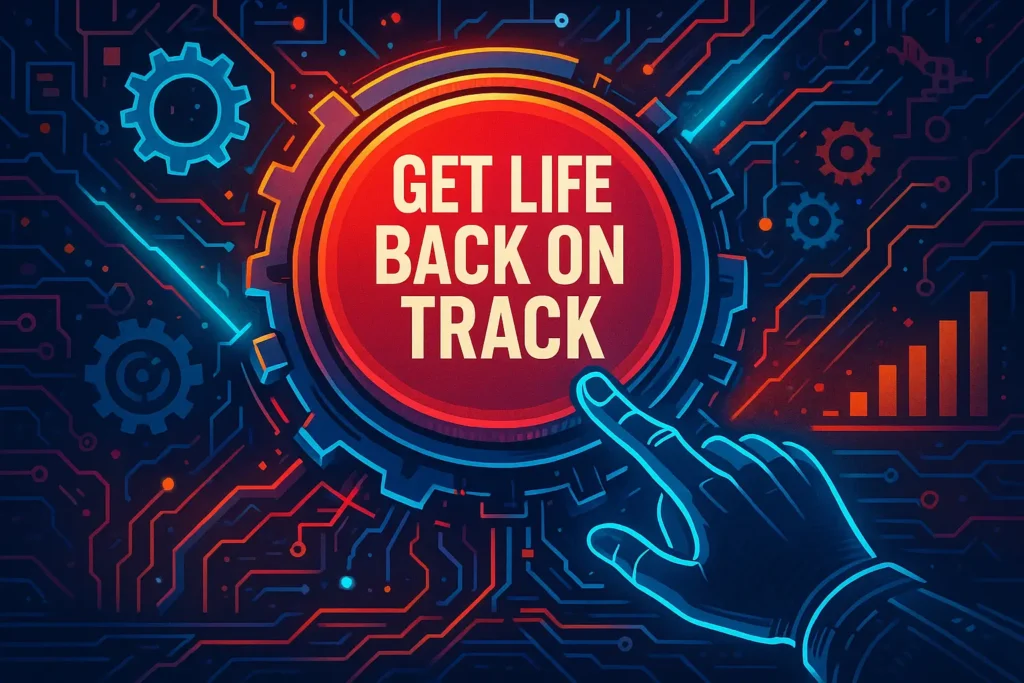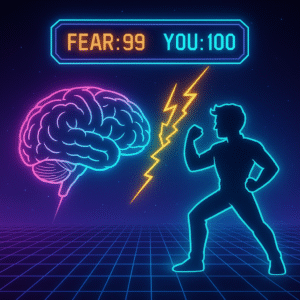Feeling like you’re drifting through life without direction? You’re not alone. Recent studies show that over 70% of adults report feeling “stuck” or off-track in at least one major area of their lives. Whether it’s a stagnant career, unfulfilling relationships, declining health, or simply feeling like you’ve lost your sense of purpose, the experience of being off-track is both common and deeply frustrating.
The internet promises quick fixes with endless articles on how to get your life back on track, but most people find themselves more confused than ever. Generic advice like “just think positive” or “set better goals” rarely addresses the deeper patterns keeping you stuck. Meanwhile, the constant flood of conflicting information creates analysis paralysis, leaving you knowing what you should do but unable to take meaningful action.
Here’s what’s different about this guide: we’re going to walk through a systematic, science-backed approach to getting your life back on track that addresses the root causes of feeling stuck, not just the symptoms. You’ll discover practical steps you can implement immediately, understand why previous attempts may have failed, and learn how to create lasting momentum in the areas that matter most.
Why Most People Stay Stuck (And Why Generic Advice Fails)
Before diving into solutions, it’s crucial to understand why so many people struggle with how to get back on track despite genuine effort and motivation.
The Information Overload Trap
We live in an era of unprecedented access to self-help resources, yet rates of anxiety, depression, and life dissatisfaction continue climbing. The problem isn’t lack of information—it’s information overload. When faced with hundreds of competing strategies, most people either freeze up entirely or constantly switch between approaches, never giving any single method enough time to work.
Research from Columbia University’s Business School shows that when people have too many choices, they often make no choice at all. This “choice paralysis” explains why browsing self-help content can actually make you feel more stuck than before you started.
The One-Size-Fits-All Problem
Most advice on how to get my life back on track assumes everyone has the same personality, circumstances, and challenges. A productivity system that works brilliantly for an extroverted entrepreneur might be completely wrong for an introverted employee. A fitness routine perfect for someone with flexible hours might be impossible for a parent juggling multiple responsibilities.
Stanford’s Behavior Design Lab has demonstrated that sustainable behavior change requires matching interventions to individual contexts. Generic advice fails because it ignores the three critical factors that determine success: your unique personality traits, your specific life circumstances, and your personal goals and values.
The Motivation vs. Consistency Gap
Perhaps the biggest misconception about getting your life back on track is the belief that motivation leads to action. In reality, research shows the opposite is often true—action leads to motivation. This explains why waiting to “feel ready” keeps you stuck indefinitely.
Dr. BJ Fogg from Stanford has shown that sustainable change comes from designing systems that work even when motivation is low. The people who successfully transform their lives don’t rely on willpower; they create environments and habits that make positive choices automatic.
Related Article: How to Build Discipline and Consistency
The 6-Step System to Get Your Life Back on Track
Now that we understand why conventional approaches fall short, let’s explore a systematic method for creating real, lasting change. This isn’t about quick fixes or temporary motivation—it’s about building momentum that compounds over time.
Step 1: Conduct an Honest Life Audit
How to get my life back on track begins with brutal honesty about where you currently stand. Most people skip this step because it can be uncomfortable, but without clear awareness of your starting point, any improvement strategy is just guesswork.
Create a simple assessment across the key areas that research shows matter most for life satisfaction:
Professional/Financial Life: Rate your satisfaction with your career trajectory, income, and financial security on a scale of 1-10. Are you growing in areas that excite you? Do you have financial breathing room?
Relationships and Social Connections: How fulfilling are your closest relationships? Do you have people you can count on? Are you contributing positively to others’ lives?
Physical Health and Energy: How do you feel in your body? Are you taking care of your basic needs for movement, nutrition, and rest? Do you have the energy to pursue what matters to you?
Mental and Emotional Well-being: How’s your stress level? Are you able to handle challenges without being overwhelmed? Do you feel emotionally balanced most of the time?
Personal Growth and Purpose: Are you learning and growing? Do you have a sense of direction and meaning in your life?
Be specific about what’s working and what isn’t. Instead of vague dissatisfaction, identify concrete issues: “I feel exhausted by 3 PM every day” or “I haven’t had a meaningful conversation with my spouse in weeks.”
Step 2: Identify Your Core Pain Points
The next step in how to get life back on track involves distinguishing between symptoms and root causes. Most people focus on surface-level problems while the deeper patterns remain unchanged.
Look for recurring themes across different areas of your life. If you’re struggling with consistency in multiple areas—exercise, work projects, relationships—the issue likely isn’t specific to any one domain. You might need better systems for following through on commitments.
If you’re feeling overwhelmed in several areas simultaneously, the problem might be boundaries. You may be saying yes to too many things or failing to protect time for what matters most.
If you feel disconnected or isolated across different contexts, the underlying issue might be authenticity. You might be presenting different versions of yourself in different situations, leading to a fragmented sense of identity.
Use the “5 Whys” technique: When you identify a problem, ask “why” five times to dig deeper. For example:
- “I’m always tired.” Why?
- “I stay up too late.” Why?
- “I procrastinate during the day.” Why?
- “I feel overwhelmed by my to-do list.” Why?
- “I don’t know how to prioritize effectively.”
Now you’ve moved from “I’m tired” to “I need better prioritization skills”—a much more actionable insight.
Step 3: Create Your Personal Recovery Blueprint
Getting your life back on track requires a customized approach based on your specific situation. This isn’t about copying someone else’s morning routine or adopting the latest productivity hack—it’s about designing solutions that fit your real life.
Start with your highest-impact, lowest-resistance changes. Research from MIT’s Behavioral Economics Lab shows that early wins create momentum for bigger changes later. Look for areas where small adjustments could create disproportionate improvements.
If you identified energy as a core issue, your first focus might be sleep hygiene or nutrition timing. If relationships are the priority, it might be scheduling regular one-on-one time with important people. If overwhelm is the pattern, it could be implementing a simple decision-making framework.
Create what researchers call “implementation intentions”—specific if-then plans that remove decision-making from the moment of action. Instead of “I’ll exercise more,” commit to “If it’s Tuesday, Thursday, or Saturday at 7 AM, then I’ll do a 20-minute walk around my neighborhood.”
Design your environment to support success. If you want to read more, place books where you currently scroll social media. If you want to eat healthier, prep nutritious snacks and put them at eye level in your fridge. Small environmental changes often produce bigger results than willpower-based approaches.
Step 4: Implement the Momentum Method
The key to how to get back on track sustainably lies in understanding momentum. Just as a rocket requires the most energy to break Earth’s gravitational pull, personal change requires the most effort at the beginning. Once you’re moving, maintaining progress becomes much easier.
Focus on consistency over intensity. Research consistently shows that people who exercise 15 minutes daily are more likely to still be exercising a year later than those who start with hour-long workouts. This principle applies to every area of life.
Use what behavioral scientists call “habit stacking”—linking new behaviors to existing routines. If you already brush your teeth every morning, that’s a perfect anchor for a new habit.”After I brush my teeth, I’ll write down three priorities for the day” is more likely to stick than trying to start a completely separate routine. This approach leverages keystone habits—small changes that create cascading positive effects across multiple aspects of life.
Track leading indicators, not just outcomes. Instead of only measuring weight loss, track daily walks. Instead of only measuring income, track skill-building activities or networking conversations. These process metrics give you more frequent feedback and help maintain motivation during inevitable plateaus.
Expect resistance and plan for it. Your brain is wired to maintain the status quo, so feeling uncomfortable with change is normal and temporary. Having strategies ready for difficult days—simplified versions of your new habits, accountability partners, or reminder systems—prevents temporary setbacks from becoming permanent derailment.
Step 5: Use AI to Personalize Your Approach
How do I get my life back on track with AI assistance? While the previous steps provide a solid framework, artificial intelligence can help you dig deeper into your specific patterns and create more personalized solutions.
AI excels at asking follow-up questions you might not think of and helping you see connections between different areas of your life. It can also help you brainstorm solutions tailored to your unique constraints and preferences.
AI PROMPT TO COPY/PASTE:
“I’m feeling stuck and need to get my life back on track. Please act as a life coach to help me conduct a comprehensive life audit and create a personalized action plan.
Please guide me through this step by step, waiting for my response before moving to each next stage:
Step 1: Current State Assessment Ask me specific questions about my satisfaction and challenges in these key areas: career/finances, relationships, physical health, mental/emotional well-being, and personal growth. For each area, help me identify both what’s working and what needs attention.
Step 2: Pattern Recognition Based on my responses, help me identify underlying patterns or themes that might be affecting multiple areas of my life. Look for connections I might have missed.
Step 3: Priority Setting Guide me to choose 1-2 areas that would create the biggest positive impact if improved. Help me understand why these should be my focus and how progress in these areas might naturally improve others.
Step 4: Personalized Action Planning Based on my specific situation, lifestyle, and preferences, suggest concrete first steps I can take this week. Make sure these suggestions are realistic given my current circumstances.”
Sample Conversation: AI:
“Let’s start with your career and finances. On a scale of 1-10, how satisfied are you with your current professional situation? What specific aspects are working well, and what feels most challenging or unfulfilling?”
You: “I’d say about a 5. I like my colleagues and the work isn’t terrible, but I feel like I’m not growing anymore. I’ve been doing the same tasks for two years, and my salary hasn’t kept up with inflation. I keep thinking about changing careers but don’t know where to start.”
AI: “Thank you for that honest assessment. It sounds like stagnation and financial pressure are key concerns. Before we explore solutions, let’s look at your other life areas to see if there are related patterns…”
This AI-guided approach can provide valuable insights, but remember that getting your life back on track requires more than just analysis—it requires a complete system for turning insights into consistent action. While AI can help you understand your situation, lasting transformation comes from having an integrated approach that addresses not just what to change, but how to make those changes stick through gamification, community support, and personalized accountability systems.
Step 6: Build Your Support System and Stay Accountable
The final piece of how to get back on track involves recognizing that sustainable change rarely happens in isolation. Research from Harvard’s Study of Adult Development shows that the quality of our relationships is the strongest predictor of long-term happiness and success.
Create multiple layers of accountability. This might include a workout partner for fitness goals, a mentor for career development, or a close friend who checks in on your overall progress. Different types of goals often benefit from different types of support.
Join or create communities around your areas of focus. Whether it’s online forums, local meetups, or structured programs, being around others who share your commitment to growth provides both motivation and practical insights.
Consider the concept of “positive peer pressure.” Surround yourself with people who are also working on self-improvement. Their example and encouragement will naturally pull you forward, while your progress will inspire them in return.
Document your journey through journaling, photos, or regular check-ins with accountability partners. This creates a record of progress that’s especially valuable during challenging periods when it feels like nothing is changing.
Finally, be patient with the process. Research shows that it takes an average of 66 days for new behaviors to become automatic, and complex life changes often take months or years to fully integrate. Getting your life back on track isn’t a destination—it’s an ongoing practice of aligned living.
Conclusion: How Do I Get My Life Back on Track
How to get your life back on track isn’t about perfection or dramatic overnight transformation. It’s about creating sustainable momentum in the areas that matter most to you. The six-step system we’ve explored—conducting an honest audit, identifying core pain points, creating a personal blueprint, implementing the momentum method, leveraging AI for personalization, and building support systems—provides a framework that adapts to your unique situation.
The most important insight from behavioral science research is that small, consistent changes compound over time into remarkable transformations. The person who feels completely stuck today can become someone living with purpose, energy, and fulfillment—but only through systematic, personalized action.
Remember, everyone’s journey of getting their life back on track looks different. Your timeline, priorities, and methods will be unique to your circumstances. What matters is starting with honest self-assessment and then taking consistent action toward the life you want to create.
Read More: How to Fix My Life
Your Path Forward:
The strategies you just discovered—conducting life audits, building momentum, and creating personalized action plans—are core components of what the AI Habits Coach does automatically.
Instead of manually working through assessments and trying to maintain motivation through willpower alone, imagine having an AI-powered, gamified system that makes getting your life back on track as engaging as playing your favorite video game.
The Moore Momentum System transforms the 6-step process you just learned into a fun, ethically addictive journey that keeps you moving forward across all 5 Core Pillars of Life: Mindset, Career & Finances, Relationships, Physical Health, and Emotional & Mental Health.
Your personalized Command Center conducts ongoing life audits through dynamic Momentum Lists, while our science-backed habit formation system eliminates the friction that keeps most people stuck. Plus, you’ll earn points, level up your progress, and connect with a community of like-minded players—all while building the momentum needed to fire on all cylinders.






